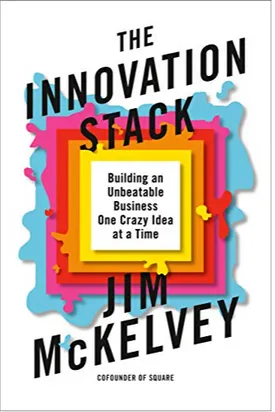The Innovation Stack: Building an Unbeatable Business One Crazy Idea at a Time by Jim McKelvey
Innovation and growth are often intertwined, but Jim McKelvey’s book “The Innovation Stack: Building an Unbeatable Business One Crazy Idea at a Time,” suggests that the two need not be mutually exclusive. As the book’s title suggests, McKelvey sees innovation as something that can be “stacked” — built through consistent and strategic work, rather than an accidental outcome.
McKelvey, a tech entrepreneur and founder of payment processing company Square, posits that a “stack” is a combination of several layers of thought-provoking, cutting-edge actions, or, in his words, “sensible risks”. These risks need to be taken, acted on and tweaked continuously in order to keep business growth humming along. He draws a comparison to the way Google and Apple are able to rapidly test and roll out features, products and strategies to stay ahead of the pack. The idea, McKelvey argues, is that a “stack” of risk-taking can be used to drive a culture of growth and continual improvement in any organization, no matter its size.
McKelvey breaks down the idea of a “stack” into seven key steps, which he outlines in the book. The first step is to define a vision, core values and mission for your organization. This sets the stage for creating the necessary structure to achieve the organization’s goals, and also provides the foundation for assessing the impact of any risks or actions taken. The second step is to develop strategies for executing on the vision and mission through product, pricing and risk analysis. This step also involves creating systems for tracking and measuring the results of any actions taken.
Step three involves actively searching for breakthrough ideas and opportunities. McKelvey argues that in order to generate true innovation, organizations need to be “idea factory” where the best and brightest team members are first connected and then inspired to act on their ideas. In step four, McKelvey suggests that organizations must embrace failure, by encouraging an environment that tests risks and iterates based on failure. Step five talks about harnessing data and analytics. McKelvey points out that the data-backed assessment of potential risks and actions is table stakes in today’s innovation-driven world.
Step six involves building a culture of individual empowerment, where employees feel safe taking risks, and where failure is seen as a legitimate part of experimentation. Finally, the seventh step involves developing a cross-functional environment, where product, marketing and other elements of the business work together to drive product decisions.
McKelvey’s book offers an interesting and inspiring framework for innovating within organizations and provides concrete strategies on how to build a culture of risk-taking and continual improvement. By viewing innovation as something that can be “stacked” rather than an accidental outcome, the book provides the necessary structure to help organizations take the right risks and allow their businesses to grow. Moreover, it offers an excellent roadmap for understanding how data and analytics, culture, and cross-functional collaboration can work together to drive tangible and lasting improvement.

